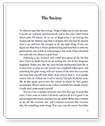Essay Instructions: Experimental Study (ES)
To write critiques, you may find articles that interest you from any research journal in the general fields of library and information sciences -- reading RESEARCH JOURNAL, not newsletters, not bulletins, not newspapers, not magazines, and not pop-science or pop-tech journals. It works best if the articles you found happen to be on the same research problem as you have chosen for your thesis proposal. Keep in mind that you need to have one article for each research method.
The U.S. Department of Education, Office of Educational Research and Improvement and the National Institute on Postsecondary Education, Libraries, and Lifelong Learning publishes executive summaries of research projects funded during the years of 1983-1997. If you follow THIS LINK, you will see a table (Table VA) that lists funded research projects, wth one column briefly describes what each research project is about and another column specifies what research method is used in the project. Armed with researchers' names and title keywords of their research, you can easily hunt down their corresponding research publications.
Nevertheless, I have rounded up some articles for each type of research method. You may choose one off this list to criticize if you have run out of time or just plain tired of hunting. Click on THIS LINK and it will take you there.
How to Approach
Once you have chosen a target piece, you will proceed to carefully read the article, not to look for spelling errors, but to critically examine how the researcher(s) defined the research problem, set up the overall research design, and handled the processes of data gathering, data processing, and data analysis. Although content presentation may be an issue worthy of commenting, your real focus should be on the research design and methodological issues. You will need to "see through" the article's wording to uncover the researchers' plan of design and what actually happened during the process of their research implementation.
Based on a good understanding of uncovered essentials and armed with knowledge you have learned about reserach methods, you proceed to form critical opinions about the research, by asking reflective questions like below. (Note that the questions listed here are suggestive only and some may not apply to the study you are reviewing.)
• Is the research problem well defined? Is it sufficently rooted in existing literature?
• Are the research questions relevant to the stated research problem? And hypotheses properly formulated?
• Is the author's choice of research method/design appropriate for investigating the research problem? If not, what is a better alternative and why?
• Is the research population properly identified? How are subjects/objects sampled, and what is the implication (bias) of the sampling/selection procedure?
• Is the data gathering (measuring) instrument appropriate? Is it pre-tested for reliability and validity? Is the instrument administered properly? Any potential bias introduced during the data gathering process? What measures have been taken (and should be taken) to ensure data quality?
• Are qualitative data (primary/secondary evidences) properly collected, processed, and interpreted?
• Is the data coding done correctly? Any coding sheet and guideline used? If two or more people involved in data coding, any check for coding reliability and inter-coder consistency?
• Are statistical analyses of quantitative data appropriate, especially for testing stated hypotheses? Did the researcher apply correct statistical procedures? Were statistical significances of findings reported? Were statistical results reported and interpreted appropriately?
• Any gaps in the research design, methodological setup, and implementation process?
• Were conclusions properly drawn from research findings? Did the researcher claim more than actually achieved?
Writing the Research Critique
Upon completion of critically examining the research, with notes handy and mind still fresh with ideas, you move on to write the critique draft. Write succinctly, accurately, and clearly, and avoid commenting on trivial and obvious things. Use the "header and footer" function to insert the course number, your last name, first initial, and page numbering within the top margine. Neither cover page nor abstract is needed. Use subheadings to mark sections, but do not break into separate pages. Avoid block quotes, tables, and figures, unless it's absolutely necessary. The maximum length is five pages, excluding references and appendix.
• Bibliographical entry of the research article you choose to work with, at the top of first page.
• Digested summary of the research (your own. not copying the abstract. no more than half a page)
• Critique (what YOU want to say about the research. This is the main body of your work)
• References if any work is cited in your own writing, not including the one under review.
A sample critique is provided here to give you some idea of how your work should be like.
When submitting, include a PDF version of the original article.
Customer is requesting that (Christiew) completes this order.


